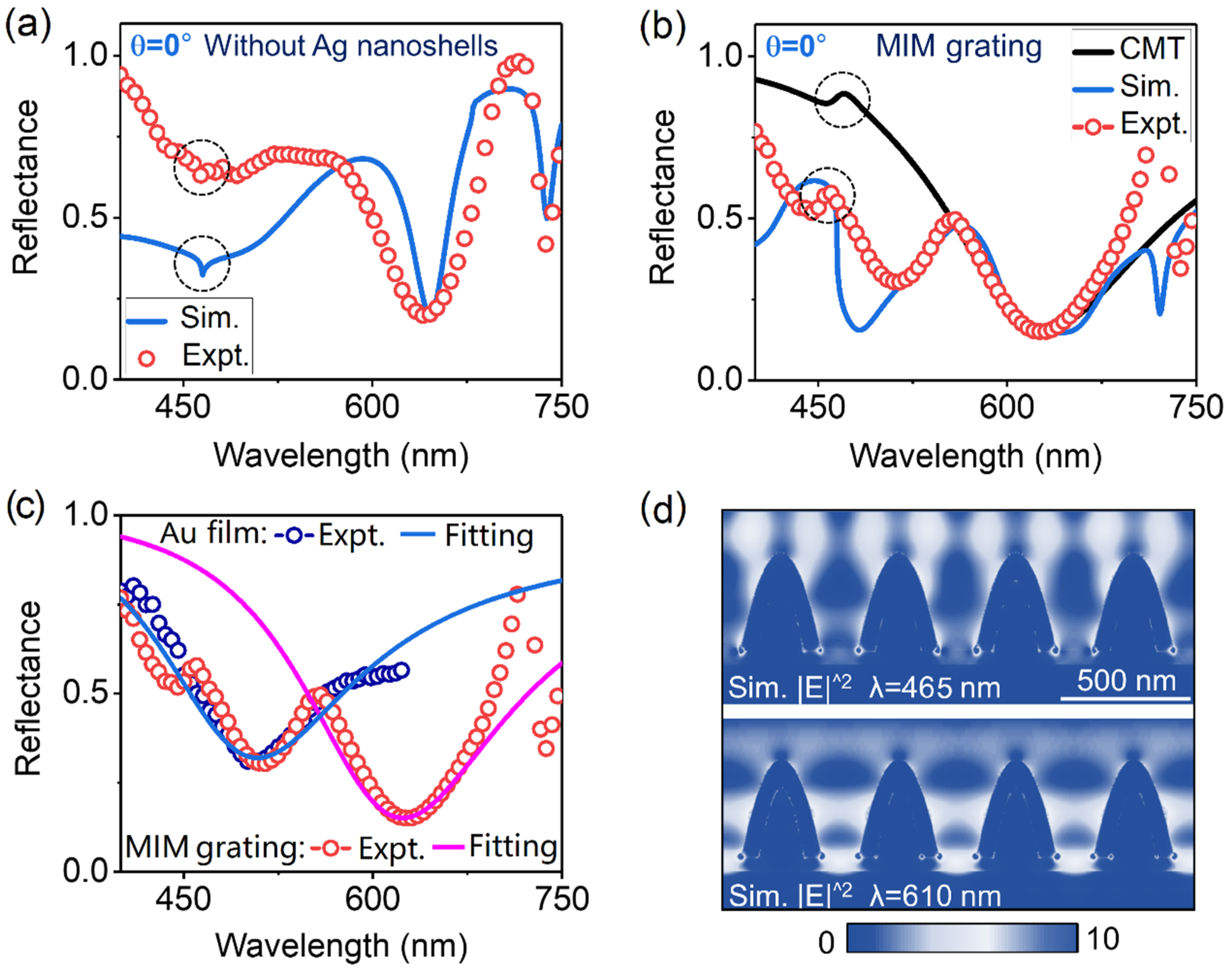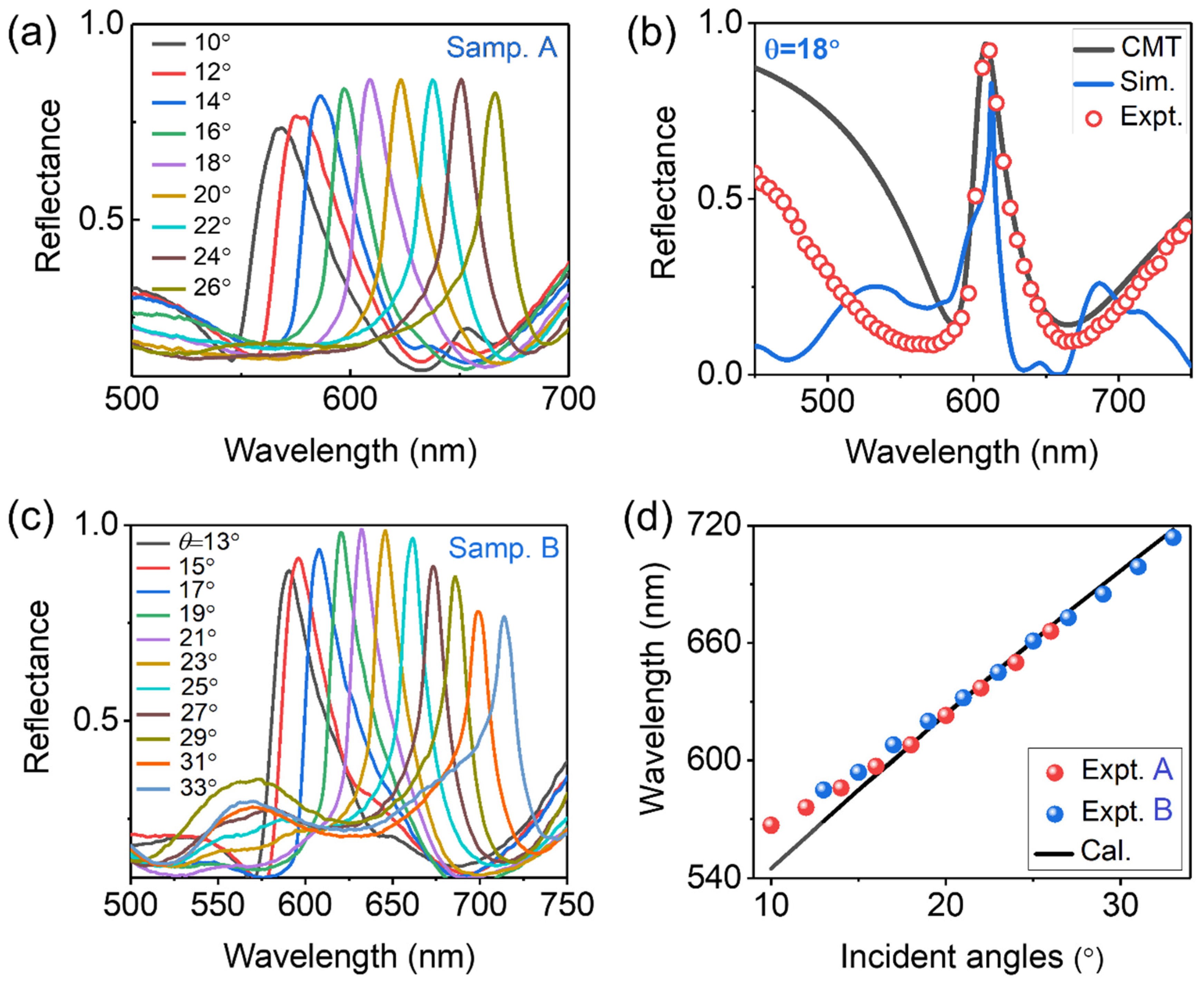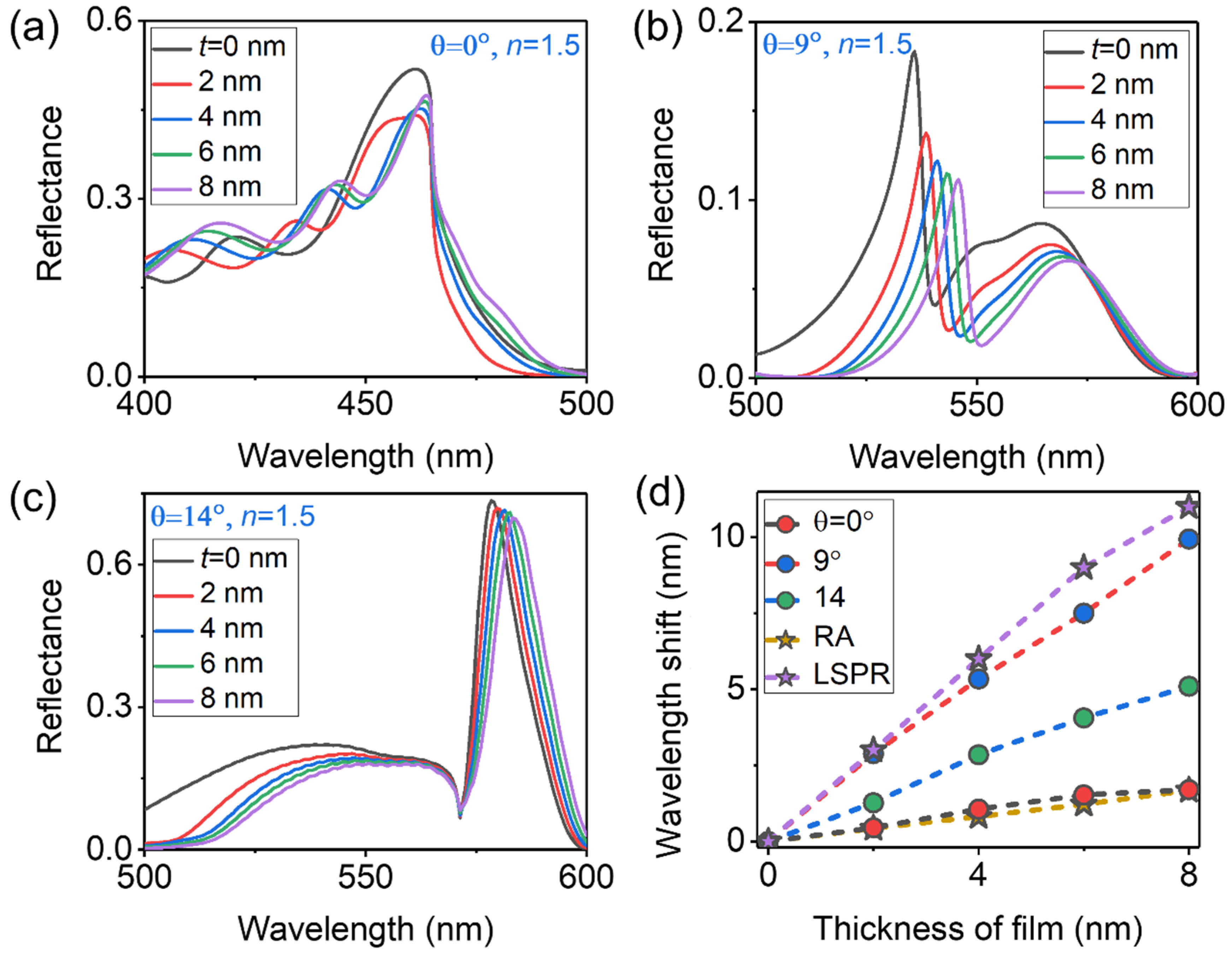Dual-Function Meta-Grating Based on Tunable Fano Resonance for Reflective Filter and Sensor Applications
Abstract
1. Introduction
2. Results
2.1. Design and Characterization of the MIM Meta-Grating
2.2. High-Contrast Fano Resonance and Its Application in Reflective Filters
2.3. Sensor Performances of the MIM Meta-Grating
3. Conclusions
Supplementary Materials
Author Contributions
Funding
Institutional Review Board Statement
Informed Consent Statement
Data Availability Statement
Conflicts of Interest
References
- Anker, J.N.; Hall, W.P.; Lyandres, O.; Shah, N.C.; Zhao, J.; van Duyne, R.P. Biosensing with plasmonic nanosensors. Nat. Mater. 2008, 7, 442–453. [Google Scholar] [CrossRef] [PubMed]
- Kabashin, A.V.; Evans, P.; Pastkovsky, S.; Hendren, W.; Wurtz, G.A.; Atkinson, R.; Pollard, R.; Podolskiy, V.A.; Zayats, A.V. Plasmonic nanorod metamaterials for biosensing. Nat. Mater. 2009, 8, 867–871. [Google Scholar] [CrossRef] [PubMed]
- Mayer, K.M.; Hafner, J.H. Localized surface plasmon resonance sensors. Chem. Rev. 2011, 111, 3828–3857. [Google Scholar] [PubMed]
- Ciracì, C.; Hill, R.T.; Mock, J.J.; Urzhumov, Y.; Fernández-Domínguez, A.I.; Maier, S.A.; Pendry, J.B.; Chilkoti, A.; Smith, D.R. Probing the Ultimate Limits of Plasmonic Enhancement. Science 2012, 337, 1072–1074. [Google Scholar] [CrossRef] [PubMed]
- Silalahi, H.M.; Chiang, W.-F.; Shih, Y.-H.; Wei, W.-Y.; Su, J.-Y.; Huang, C.-Y. Folding metamaterials with extremely strong electromagnetic resonance. Photonics Res. 2022, 10, 2215–2222. [Google Scholar] [CrossRef]
- Becker, J.; Trügler, A.; Jakab, A.; Hohenester, U.; Sönnichsen, C. The Optimal Aspect Ratio of Gold Nanorods for Plasmonic Bio-sensing. Plasmonics 2010, 5, 161–167. [Google Scholar] [CrossRef]
- Chen, H.; Kou, X.; Yang, Z.; Ni, W.; Wang, J. Shape- and Size-Dependent Refractive Index Sensitivity of Gold Nanoparticles. Langmuir 2008, 24, 5233–5237. [Google Scholar] [CrossRef]
- Tam, F.; Moran, C.; Halas, N. Geometrical Parameters Controlling Sensitivity of Nanoshell Plasmon Resonances to Changes in Dielectric Environment. J. Phys. Chem. B 2004, 108, 17290–17294. [Google Scholar] [CrossRef]
- Colombelli, A.; Lospinoso, D.; Rella, R.; Manera, M.G. Tunable Nanoplasmonic Transducers: Performance Analysis and Potential Application. Chemosensors 2023, 11, 109. [Google Scholar]
- Scroccarello, A.; Della Pelle, F.; Del Carlo, M.; Compagnone, D. Optical plasmonic sensing based on nanomaterials integrated in solid supports. A critical review. Anal. Chim. Acta 2023, 1237, 340594. [Google Scholar]
- Shen, Y.; Zhou, J.; Liu, T.; Tao, Y.; Jiang, R.; Liu, M.; Xiao, G.; Zhu, J.; Zhou, Z.-K.; Wang, X.; et al. Plasmonic gold mushroom arrays with refractive index sensing figures of merit approaching the theoretical limit. Nat. Commun. 2013, 4, 2381. [Google Scholar] [PubMed]
- Christ, A.; Tikhodeev, S.; Gippius, N.A.; Kuhl, J.; Giessen, H. Waveguide-Plasmon Polaritons: Strong Coupling of Photonic and Electronic Resonances in a Metallic Photonic Crystal Slab. Phys. Rev. Lett. 2003, 91, 183901. [Google Scholar] [CrossRef] [PubMed]
- Zhang, X.; Ma, X.; Dou, F.; Zhao, P.; Liu, H. A Biosensor Based on Metallic Photonic Crystals for the Detection of Specific Bioreactions. Adv. Funct. Mater. 2011, 21, 4219–4227. [Google Scholar] [CrossRef]
- Ameling, R.; Langguth, L.; Hentschel, M.; Mesch, M.; Braun, P.V.; Giessen, H. Cavity-enhanced localized plasmon resonance sensing. Appl. Phys. Lett. 2010, 97, 253116. [Google Scholar] [CrossRef]
- Bahramipanah, M.; Dutta-Gupta, S.; Abasahl, B.; Martin, O.J.F. Cavity-Coupled Plasmonic Device with Enhanced Sensitivity and Figure-of-Merit. ACS Nano 2015, 9, 7621–7633. [Google Scholar] [CrossRef]
- Liu, F.; Zhang, X.; Mu, Y.; Lin, J.; Wang, M.; Ma, H. Complementary Dark and Bright Plasmonic Nanocavities with Controllable Energy Exchange for SERS Sensing. Adv. Opt. Mater. 2020, 8, 2000544. [Google Scholar] [CrossRef]
- Hao, F.; Sonnefraud, Y.; Dorpe, P.V.; Maier, S.A.; Halas, N.J.; Nordlander, P. Symmetry Breaking in Plasmonic Nanocavities: Subradiant LSPR Sensing and a Tunable Fano Resonance. Nano Lett. 2008, 8, 3983–3988. [Google Scholar]
- Sonnefraud, Y.; Verellen, N.; Sobhani, H.; Vandenbosch, G.A.; Moshchalkov, V.V.; Van Dorpe, P.; Nordlander, P.; Maier, S.A. Experimental Realization of Subradiant, Superradiant, and Fano Resonances in Ring/Disk Plasmonic Nanocavities. ACS Nano 2010, 4, 1664–1670. [Google Scholar] [CrossRef]
- Liu, F.; Zhang, X. Fano coupling between Rayleigh anomaly and localized surface plasmon resonance for sensor applications. Biosens. Bioelectron. 2015, 68, 719–725. [Google Scholar] [CrossRef]
- Jia, S.; Li, Z.; Chen, J. High-sensitivity plasmonic sensor by narrowing Fano resonances in a tilted metallic nano-groove array. Opt. Express 2021, 29, 21358–21368. [Google Scholar] [CrossRef]
- Choi, B.B.; Kim, B.; Bice, J.; Taylor, C.; Jiang, P. Inverse DVD-R grating structured SPR sensor platform with high sensitivity and figure of merit. J. Ind. Eng. Chem. 2022, 116, 321–330. [Google Scholar] [CrossRef]
- Omam, Z.R.; Ghobadi, A.; Khalichi, B.; Ozbay, E. Fano resonance in a dolomite phase-change multilayer design for dynamically tunable omnidirectional monochromatic thermal emission. Opt. Lett. 2022, 47, 5781–5784. [Google Scholar] [CrossRef] [PubMed]
- Pan, Y.; Lan, F.; Zhang, Y.; Zeng, H.; Wang, L.; Song, T.; He, G.; Yang, Z. Dual-band multifunctional coding metasurface with a mingled anisotropic aperture for polarized manipulation in full space. Photonics Res. 2022, 10, 416. [Google Scholar] [CrossRef]
- Silalahi, H.M.; Shih, Y.-H.; Lin, S.-H.; Chen, Y.-T.; Wei, W.-Y.; Chao, P.-L.; Huang, C.-Y. Electrically controllable terahertz metamaterials with large tunabilities and low operating electric fields using electrowetting-on-dielectric cells. Opt. Lett. 2021, 46, 5962–5965. [Google Scholar] [CrossRef] [PubMed]
- Liu, S.; Xu, F.; Zhan, J.; Qiang, J.; Xie, Q.; Yang, L.; Deng, S.; Zhang, Y. Terahertz liquid crystal programmable metasurface based on resonance switching. Opt. Lett. 2022, 47, 1891. [Google Scholar] [CrossRef] [PubMed]
- Zhao, F.; Li, Z.; Li, S.; Dai, X.; Zhou, Y.; Liao, X.; Cao, J.C.; Liang, G.; Shang, Z.; Zhang, Z.; et al. Terahertz metalens of hyper-dispersion. Photonics Res. 2022, 10, 886. [Google Scholar] [CrossRef]
- Luk’Yanchuk, B.; Zheludev, N.I.; Maier, S.A.; Halas, N.J.; Nordlander, P.; Giessen, H.; Chong, C.T. The Fano resonance in plasmonic nanostructures and metamaterials. Nat. Mater. 2010, 9, 707–715. [Google Scholar]
- Hessel, A.; Oliner, A.A. A New Theory of Wood’s Anomalies on Optical Gratings. Appl. Opt. 1965, 4, 1275–1297. [Google Scholar] [CrossRef]
- Eitan, M.; Iluz, Z.; Yifat, Y.; Boag, A.; Hanein, Y.; Scheuer, J. Degeneracy Breaking of Wood’s Anomaly for Enhanced Refractive Index Sensing. ACS Photonics 2015, 2, 615–621. [Google Scholar] [CrossRef]
- Feng, S.; Darmawi, S.; Henning, T.; Klar, P.J.; Zhang, X. A Miniaturized Sensor Consisting of Concentric Metallic Nanorings on the End Facet of an Optical Fiber. Small 2012, 8, 1937–1944. [Google Scholar] [CrossRef]
- Zhang, X.; Feng, S.; Zhai, T. Energy transfer channels at the diffraction-anomaly in transparent gratings and applications in sensors. Photonics Nanostruct.-Fundam. Appl. 2013, 11, 109–114. [Google Scholar] [CrossRef]
- Liu, F.; Zhang, X. Contrast- and intensity-enhancement of sensor signals based on Rayleigh anomaly in metal-coated gratings. Opt. Mater. Express 2016, 6, 682–690. [Google Scholar] [CrossRef]
- Qu, C.; Ma, S.; Hao, J.; Qiu, M.; Li, X.; Xiao, S.; Miao, Z.; Dai, N.; He, Q.; Sun, S.; et al. Tailor the Functionalities of Metasurfaces Based on a Complete Phase Diagram. Phys. Rev. Lett. 2015, 115, 235503. [Google Scholar] [CrossRef] [PubMed]
- Liu, N.; Mesch, M.; Weiss, T.; Hentschel, M.; Giessen, H. Infrared Perfect Absorber and Its Application As Plasmonic Sensor. Nano Lett. 2010, 10, 2342–2348. [Google Scholar] [CrossRef] [PubMed]
- Liu, F.; Zhang, X.; Fang, X. Plasmonic plano-semi-cylindrical nanocavities with high-efficiency local-field confinement. Sci. Rep. 2017, 7, 40071. [Google Scholar] [CrossRef]
- Fan, S.; Suh, W.; Joannopoulos, J.D. Temporal coupled-mode theory for the Fano resonance in optical resonators. J. Opt. Soc. Am. A 2003, 20, 569–572. [Google Scholar] [CrossRef]
- Kan, Y.; Andersen, S.K.H.; Ding, F.; Kumar, S.; Zhao, C.; Bozhevolnyi, S.I. Metasurface-Enabled Generation of Circularly Polarized Single Photons. Adv. Mater. 2020, 32, e1907832. [Google Scholar] [CrossRef]
- Korkmaz, S.; Turkmen, M. Dual-band plasmonic perfect absorber for refractive index sensing from mid- to near infrared region. J. Electromagn. Waves Appl. 2023, 37, 782–793. [Google Scholar] [CrossRef]
- Li, Y.; An, B.; Jiang, S.; Gao, J.; Chen, Y.; Pan, S. Plasmonic induced triple-band absorber for sensor application. Opt. Express 2015, 23, 17607–17612. [Google Scholar] [CrossRef]
- Zhou, W.; Li, K.; Song, C.; Hao, P.; Chi, M.; Yu, M.; Wu, Y. Polarization-independent and omnidirectional nearly perfect absorber with ultra-thin 2D subwavelength metal grating in the visible region. Opt. Express 2015, 23, A413–A4138. [Google Scholar] [CrossRef]
- Korkmaz, S.; Oktem, E.; Yazdaanpanah, R.; Aksu, S.; Turkmen, M. Experimental Study of a Quad-Band Metamaterial-Based Plasmonic Perfect Absorber as a Biosensor. Molecules 2022, 27, 4576. [Google Scholar] [CrossRef] [PubMed]
- Luo, X.; Tan, R.; Li, Q.; Chen, J.; Xie, Y.; Peng, J.; Zeng, M.; Jiang, M.; Wu, C.; He, Y. High-sensitivity long-range surface plasmon resonance sensing assisted by gold nanoring cavity arrays and nanocavity coupling. Phys. Chem. Chem. Phys. 2023, 25, 9273–9281. [Google Scholar] [CrossRef] [PubMed]
- Wang, Q.; Hou, L.; Li, C.; Zhou, H.; Gan, X.; Liu, K.; Xiao, F.; Zhao, J. Toward high-performance refractive index sensor using single Au nanoplate-on-mirror nanocavity. Nanoscale 2022, 14, 10773–10779. [Google Scholar] [CrossRef] [PubMed]






| Ref. | [11] | [34] | [38] | [39] | [40] | [41] | [15] | [42] | [43] | Our Device |
|---|---|---|---|---|---|---|---|---|---|---|
| Sensitivity (max) nm/RIU | 1015 | 400 | 2382.5 | 452 | 300 | 1335.69 | 547.5 | 695 | 360 | 465 |
| FOM (max) (RIU−1) | 108 | 2 | 28.3 | 30.3 | 2 | 6.35 | 58 | 96.5 | 11.2 | 57 |
| Working wavelength (nm) | 1240–1350 | 1685–1744 | 2200–8600 | 500–800 | 400–700 | 2000–11,000 | 600–1000 | 700–1000 | 500–900 | 450–900 |
Disclaimer/Publisher’s Note: The statements, opinions and data contained in all publications are solely those of the individual author(s) and contributor(s) and not of MDPI and/or the editor(s). MDPI and/or the editor(s) disclaim responsibility for any injury to people or property resulting from any ideas, methods, instructions or products referred to in the content. |
© 2023 by the authors. Licensee MDPI, Basel, Switzerland. This article is an open access article distributed under the terms and conditions of the Creative Commons Attribution (CC BY) license (https://creativecommons.org/licenses/by/4.0/).
Share and Cite
Liu, F.; Jia, H.; Chen, Y.; Luo, X.; Huang, M.; Wang, M.; Zhang, X. Dual-Function Meta-Grating Based on Tunable Fano Resonance for Reflective Filter and Sensor Applications. Sensors 2023, 23, 6462. https://doi.org/10.3390/s23146462
Liu F, Jia H, Chen Y, Luo X, Huang M, Wang M, Zhang X. Dual-Function Meta-Grating Based on Tunable Fano Resonance for Reflective Filter and Sensor Applications. Sensors. 2023; 23(14):6462. https://doi.org/10.3390/s23146462
Chicago/Turabian StyleLiu, Feifei, Haoyu Jia, Yuxue Chen, Xiaoai Luo, Meidong Huang, Meng Wang, and Xinping Zhang. 2023. "Dual-Function Meta-Grating Based on Tunable Fano Resonance for Reflective Filter and Sensor Applications" Sensors 23, no. 14: 6462. https://doi.org/10.3390/s23146462
APA StyleLiu, F., Jia, H., Chen, Y., Luo, X., Huang, M., Wang, M., & Zhang, X. (2023). Dual-Function Meta-Grating Based on Tunable Fano Resonance for Reflective Filter and Sensor Applications. Sensors, 23(14), 6462. https://doi.org/10.3390/s23146462







